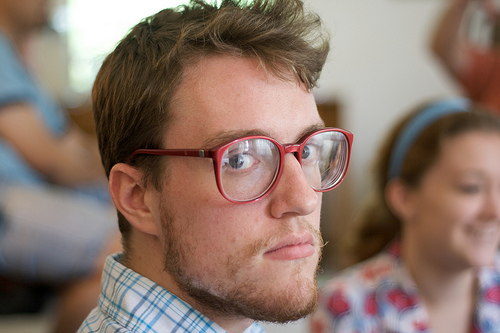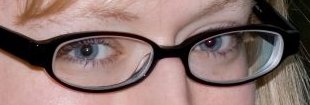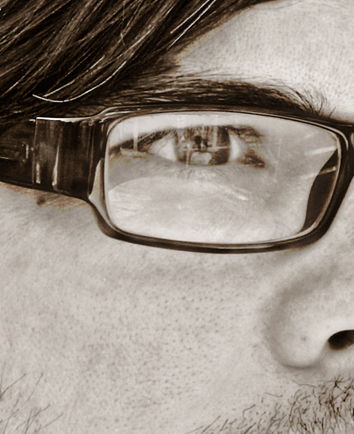-
Vad man kan tänka på och hur man ska köpa
-
Om glasögonbågar
-
Tips om starka glas, högbrytande glas och progressiva glas
-
Ytbehandling
-
Länk till räknare för att räkna ut tjockleken på glas
-
Länk till räknare för att omvandla ett glasögonrecept till ett kontaktlinsrecept
Val av bågar
En optiker tipsade mig om att glasögonens bredd ska vara lika med käkens bredd, och det verkade stämma både på mina nuvarande glasögon och de nya.
Trenden är också mot att glasögon ska synas. Detta är nog eftersom man om man ville vara diskret med sin synkorrigering, hellre nog väljer kontaktlinser eller laserbehandling.
Däremot är det bra även i glasögon om dina ögon syns. Blanka bågar, ljusa bågar och bågar i färger som inte passar med dina ögon konkurrerar med dina ögon. Mörkare bågar, matta bågar, färger som accentuerar dina ögon, antireflexbehandling och asfäriska linser gör det däremot lättare för andra att se dina ögon.
Nu går modet mot stora glasögon. Min uppfattning är att vissa passar bara i stora eller smala glasögon.

Den här killen har en kraftig käke och kan därför bära upp ett par stora glasögon. Notera dock att bågfärgen tillsammans med glasblänk gör att man inte kan uppfatta hans ögonfärg (Källa cc-by-sa)

Om man accepterar att bågar ska synas så kan man ha svarta bågar även om man har ljusa färger i ansiktet. Ingen bågfärg eller -blänk stör ögonen. (Källa cc-by-sa)

Här skulle man kunna säga fantastisk antireflexbehandling, men det är nog inget glas alls i bågen (Källa cc-by-sa)
Om man har stor styrka på glasögonen kan det vara en idé att ha förhållandevis små glas med korta diagonaler (dvs mer runda). Vissa bågar har en bredd utanför glasen, och detta är gynnsamt för att få ner tjockleken på starka glas, utan att se ut som om man har för små glasögon. Breda skalmfästen hjälper också att dölja glasens tjocklek.

Ett brett skalmfäste kan hjälpa till att maskera ett tjockt glas
(källa cc-by-sa)
Tjocka bågar i t ex plast kan också dölja tjockleken. Ett högre brytningsindex ger tunnare glas, men som diskuteras nedan så är det effektivare med mindre glas vad gäller att tunna ut dem.
Jag har på senaste tiden iakttagit folk på stan och deras glasögon. Min slutsats är att det vimlar av snygga glasögon men att de inte alltid passar till ansiktet de sitter på.
Material
Titan är lätt som aluminium och starkt som stål ungefär. Ju större bågare och starkare glas man har så är det ju snarare vikten på glasen som dominerar dock. Titan är ett dyrare men lättare alternativ till plåt.
Funktion med progressiva glas
Det har länge varit en trend att ha glasögon som är smala i höjdled. Detta framhäver kindbenet, men det ger ett begränsat synfält i höjdled. Det gör det också svårt att ha progressiva glas i bågarna.
Man brukar räkna med att man vill ha minst 30mm i höjdled för progressiva glas, vilket innebär at man kan vinka hejdå till en stor del av Oakleys sortiment t ex.
Det finns dock något som heter short corridor progressive lenses, som man kan försöka med (diskussion här). Vad gäller bågar som är öppna nedåt kan man också helt sonika förlänga glaset längre än vad som designen är avsedd för. En kompis fru fick detta utfört på sina halvgarnityrglasögon och är nöjd.
Man kan också ha dubbel- eller trippelslipade glasögon, med skarpa övergångar. Det utnyttjar glashöjden effektivare, men man gick modemässigt ifrån det för att det ger en uppenbar ålderssignal, tror jag. Rätta mig gärna i kommentarerna om det finns några optiska fördelar med progressiva jämfört med dubbel- och trippelslipade. Tack vare att progressiva tagit över så mycket så undrar jag om det inte kan vara rätt "safe" att gå tillbaka på dubbel- och trippelslipade eftersom ingen känner igen det längre. Utom äldre såklart :-)
Glasögonmärken
De märken som jag personligen fastnade för var Oakley, Puma och Rudy project.

Rudy project Slicer Aluminium, med flip-ups
Specsavers hade faktiskt också några riktigt trevliga ur märkena Quiksilver och Animal. Man får dock inte låna hem från Specsavers + att det var billigare material i de bågarna (och billigare pris förvisso). Ej hemlån var en dealbreaker för mig. Specsavers i Storbritannien håller ungefär halva priset mot Sverige, men det verkar svårt att beställa; de verkar aktivt hindra att man beställer utanför varje lands affärsområde.
Skaffa först ett glasögonrecept
Jag valde att gå till en optiker för att få ett recept, som jag sedan kunde gå vidare med. På så sätt så kan man t ex välja att handla glasögonen på Internet eller av en annan optikbutik. Jag valde till sist också att köpa bågarna på ett ställe, och glasen på ett annat. På så sätt fick jag maximal frihet, utan att det blev dyrare.
Internetbutiker mot fysiska butiker
Jag var beredd att ge 1000:- extra totalt i en fysisk butik för glasögonen. Detta eftersom jag bl a använder deras bågar för att prova och fundera. De är ju inga välgörenhetsinrättningar, och det är också bekvämt att ha en butik man kan gå till efter köpet.
Internetbutiker
Detta är de internetbutiker som jag fann intressanta. De ligger alla i EU vilket gör att man slipper tull, och dessutom svensk moms för de som ligger utanför Sverige:
Iris Optical - Har tre riktiga butiker i London, och har ett intressant sortiment.
www.smartbuyglasses.se - Skeppar till enhetspris över hela världen. Har domänen smartbuyglasses i .com, i .uk, .de, .dk, .fr, .es, .at, .ch och .it ( i vissa skickas man vidare till annat namn men det är samma sajt). Smartbuglasses ersätter en för tullkostnader om de skulle uppstå, enligt sajten.
också brittiska, och sajten ingav förtroende
Att bara sätta in glas på Internet
Det finns butiker på Internet som specialiserar sig på att sätta in glas i befintliga bågar. På engelska kallas proceduren reglazing. Jag tar upp två här, en eftersom den ligger i Sverige, och en brittisk eftersom den erbjuder asfärisk slipning som tillval i beställningsformuläret.
optikbutiken.se - Har fått bra recensioner på nån rejtingsajt. Två betyg på dem var låga där, men det var folk som klagade på bemötande i telefon, och det har ju inte med linsernas kvalitet att göra
http://www.thinlenses.co.uk/
Där kan man beställa asfäriska glas direkt i webbformuläret. För 1.67 blir det £195 just nu, eller knappt 2000 SEK med dagens gynnsamma växelkurs. Det står inte vilket märke och modell de använder på glasen. Som namnet på butiken antyder så specialiserar de sig på högbrytande glas.
Glas
Mineralglas och plastglas
Det vanligaste idag är plastglas, och över Internet är det det enda alternativet. Glas (mineralglas) har dock några fördelar:
-
Billigare
-
Hårdare
-
Bättre optisk kvalité
Nackdelarna är att det är
-
Tyngre
-
Kan splittras vid olyckor
-
Bara kan användas i bågar som har en ram hela vägen runt glaset
Tjocklek på glasen & brytningsindex
Ju högre brytningsindex ett glas har, desto tunnare kan det göras för samma styrka. Många optiker erbjuder något de kallar "standardglas", och de kan ofta fås "gratis" med bågen. Dessa har brytningsindex 1,5 och är gjorda i glas (mineralglas). Nästa nivå upp med plastglas är 1,6 , sedan 1,67 och högre kan vara t ex 1,74 . Det är en rejäl prisskillnad mellan 1,67 och 1,74 och även från 1,5 och upp till 1,6.
Man kan räkna ut tjockleken på plast- eller mineralglas med den här kalkylatorn. Vanliga mått på frame bridge (näsdelen) är 19mm, på frame eyesize (bredden på ett glas) är 53mm och på interpupillary distance (pupillavstånd) 62 mm. Man ska dock ta dessa mått från de glasögon man är intresserad av och ens glasögonrecept. Om jag väljer mina mått och slår in rätt rejäla mått på närsynthet så får jag dessa kanttjocklekar för olika brythingsindex:
|
1,6 i glas |
8,9mm |
|
1,7 i glas |
7,7mm |
|
1,8 i glas |
6,8mm |
|
1,9 i lantalglas |
6,3mm |
|
1,6 i plast |
~9mm |
|
1,67 i plast |
8,2mm |
|
1,74 i plast |
7,4mm |
|
|
|
Man kan se ur denna tabell att en halvering av tjockleken aldrig är möjlig. Istället får man nog ställa up en tjockhetsgräns, och sedan variera glasstorlek och brytningsindex. Däremot är det väldigt effektivt att variera storleken på glasen: En tioprocentig minsking av glasets bredd ger med de parametrar jag använde en minskning i tjocklek med nästan 30% vid brytningsindex 1,67.

Genom att välja bågar med en bred framkant utanför glasen, kan man minska glasens storlek utan att bågarna som helhet blir för smala till ansiktet
Sex millimeters tjocklek på glasets kant känns som en estetisk gräns.
Om man ska ha glasen i halvgarnityr eller helt utan omgivande båge så måste glasen för det första vara gjorda i plast vilket bara det gör dem lite tjockare jämfört med glas, och dessutom så ökar de extra i tjocklek för att kunna vara del av den bärade strukturen i bågen.
Asfärisk slipning
Linser kan slipas asfäriskt. Då blir de tunnare vid samma brytningsindex än ett vanligt (sfäriskt) glas. Man får inte samma förstoring/förminskningsproblem heller, dvs man ser saker genom dem mer i normal storlek och ens ögon blir inte heller så förminskade/förstorade genom dem. Det sistnämnda är ju en klar kosmetisk fördel.
Även om ögonen se mer normala ut genom asfäriska glas så kvarstår vid glas för närsynthet, det kosmetiska problemet med att sidorna på huvudet kan dras in optiskt och man ser sammanklämd ut genom glasen. Det faktum att ögonen dock ser normalstora ut i den asfäriska slipningen gör effekten lite överraskande och främmande.
Det finns dessutom andra små slipningstricks (slipa på framsidan/baksidan, ta hänsyn till pupillens bågrörelse), men de kan jag inte så mycket om.
Ytbehandling
Glas kan ytbehandlas för att ge mindre reflexer, en s k antireflexbehandling. Det har både en praktisk och en kosmetisk fördel. Den praktiska är vid t ex bilkörning när man blir mindre störd av strålkastare och annat ljus, kosmetiskt så syns ögonen bättre genom glasen utan blänk.
Antireflexbehandling är extra viktigt när man har högbrytande glas, detta eftersom de störande reflektionerna blir mycket kraftigare med högre brytningsindex. Antireflexbehanling är helt enkelt en beläggning utanpå glaset med ett brytningsindex mellan luft och glaset.
Det finns också ytbehandling som är smutsavvisande och vattenavvisande. Smuts är ofta fett, och en ytbehandling som är fettavvisande kallas på engelska för oleophobic. En vattenavvisande ytbehandling kallas på engelska hydrophobic.
För plastglas är också hårdhetsbehandling viktig. Det verkar varar stor kvalitetsskillnad mellan olika sådana behandlingar. Här en rapport (pdf) från Testfakta. Tyvärr skriver de inte ut vilka som tillverkat glasen (Zeiss, Hoya, osv) eller vilken av dessas respektive ytbehandlingar som då använts. Det finns en risk (eller möjlighet om man så vill) att någon av de namngivna svenska leverantörerna har bytt sedan testet.
Polariserande glas
Polariserande glasögon tar bort ljus som rör sig horisontellt i sin vågrörelse. Detta hjälper med att ta bort reflexer från vatten, t ex på sjön eller vid bilkörning i regn. Även glas och metall kan reflektera polariserat ljus, och himlen kan ge ifrån sig polariserat ljus.
Polariserande glasögon stjäl alltid ljus. Teoretiskt sett kan polariserande glas släppa igenom 50% av ljuset, men med den metod man mest använder i glasögon, Polaroid, så släpps max runt 38% av ljuset igenom. Polariserande glas verkar därför inte vara någon höjdare för mörker- och skymmningsbruk.
Det verkar lite småsvårt att hitta högbrytande glas med polariserande förmåga. Finns på B2B-sajten Ali Baba.
Vad blev det?
Bågar
Jag valde till sist att köpa bågarna i en butik eftersom de inte var dyrare där för den modellen och för att just den modellen bara fanns på Internet i en tjeckisk butik(!). Jag var dessutom beredd att betala lite mer till butiken i vilket fall som helst. I detta fall gick det ganska jämnt ut.

Pumaglasögon
Linser
Jag valde till slut att beställa linserna i en butik. En orsak till detta var att jag ville ha asfäriska linser och nästan inga webbsajter listar priser på asfäriska linser, så det hade blivit en extra förfrågan om detta, och prispåslag. Jag kom fram till att med påslaget för asfäriska glas så verkade det också som om prisskillnaden kom under min magiska tusenkronorsgräns mellan butik och Internet.
Jag valde Hoya 1,67 enkelslipade asfäriska, med bästa hårdhets- och antireflexbehandlingen.
Kontaktlinser
Här finns en kalkylator för att omvandla från ett glasögonrecept till ett kontaktlinsrecept.
Man kan nämligen inte använda styrkorna från sitt glasögonrecept till kontaktlinser. Anledningen till detta är att ju närmare linsen sitter ögat, desto svagare kan den vara för att ge samma synkorrigering. Man kan själv prova detta med sina glasögon genom att föra dem närmare och längre bort från ögonen (tips: om du är närsynt och behöver se bättre på nära håll tillfälligt, skjut fram glasögonen på näsan). Det går däremot att omvandla ett glasögonrecept till ett kontaktlinsrecept, t ex med ovanstående kalkylator.
Kom ihåg att det kan finnas andra skäl att ändå besiktiga ögonen hos en kontaktlinsoptiker.
Progressiva glas och att ångra glas
Om man ska ha progressiva glas, eller misstänker att man kanske behöver det, tycks det mig vara mycket bättre att handla glas i affär än på nätet. Det finns flera skäl till det. För det första så är det viktigt var i höjdled på glasen som övergången mellan fjärr- och när/medelseende inträffar. Var man vill ha den övergången beror på hur högt glasögonen sitter på näsan och på personliga preferenser. Det kan inte ett formulär på webben hjälpa en med.
För det andra så kan man hos många optiker ångra sig vad gäller slipning av glasen efter man har fått dem. Detta kan man använda till att prova en annan styrka i vanliga glas som fungerar bättre för när- och fjärrseende, utan extra kostnad, dvs en svagare styrka. Om man vill ändra från enkelslipade glas till progressiva glas kan man också göra det, med endast en tilläggskostnad. Kolla med optikern att denna möjlighet finns.






